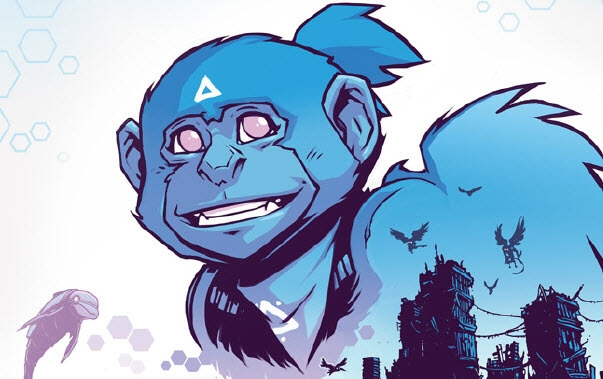Simon Spurrier isn’t a writer who shies away from meta-commentary and homage, and in just one issue, Angelic may eclipse his previous forays into zeitgeist and comics-as-sociology. Angelic #1 (Image) is a title perfect for sucking in people who think comics are all about capes and cowls and look down on the medium because of it. At first glance, it feels like a completely different creature than his previous Image title, Cry Havoc, but that’s a trick of Caspar Wijngaard’s sweet, playful art.
The issue opens on charming, cartoony monkeys in every color of the rainbow, sporting fully functional wings and the ability to speak. There are also some standard gibbons, who apparently serve as an early warning system for their more colorful companions. From the very first panel, Wijngaard gives readers bright, appealing art that toes the line between cartoony and caricature: the monkeys of both varieties are accurate in anatomy (barring the wings), and their facial expressions are only slightly exaggerated. It’s a similar impression that Beast Boy from the Teen Titans Go! cartoon gives when he transforms. You can tell exactly what he’s supposed to be, but it’s a heightened version of a very real thing.
The second page deposits readers straight into the world that Spurrier and Wijngaard have created, and this quick pace doesn’t let up for the rest of the issue. It’s Animal Farm meets A Clockwork Orange, with some Watership Down, The Handmaid’s Tale, and a hefty dose of the best kinds of girl-centered YA adventure for flavor. There are techno-dolphins that speak like steampunk LARPers, hermit crabs in what appear to be human skulls, and mysterious makers that gave the monkeys all of their extra abilities. Described like that, it sounds like a bit of a mess, but Spurrier and Wijngaard have taken all these disparate influences and massaged them into a fun and funny story.
Compared to Cry Havoc, Angelic may feel light and fluffy at first. But as the layers unfold to reveal the rotten underpinning of the monkeys’ world, it’s clear the books are more closely related than one might think. Qora, a young female monkey who delights in pushing the boundaries of what is allowed, mostly out of curiosity, is at the center of Angelic, and Cry Havoc was about a young woman who fought against similar expectations, only to end up a cog in the zeitgeist machine. Cry Havoc wore violence and sex right in the open, but Angelic masks the problems under surreal and hilarious designs and art that looks like it would be kid-friendly, if it weren’t for the subject matter.
Spurrier successfully unveils secrets without distracting the reader—though the issue is a bit exposition heavy—and he does an even better job of getting out of Wijngaard’s way and letting his excellent expressions and body language do a lot of heavy lifting for the story. Not-so-subtle lettering choices by Jim Campbell are particularly important on a couple panels, and overall the team makes the book as immersive as it can be.

